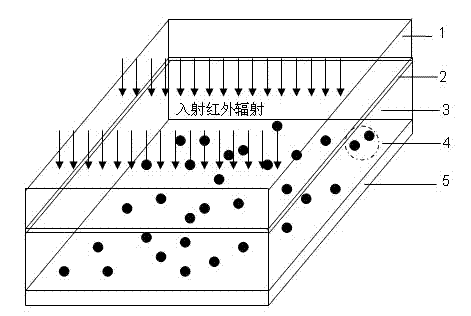Near infrared photoelectric detector with enhancement based on utilization of indium tin oxide nanoparticles
A nanoparticle and indium tin oxide technology, which is applied in the field of photodetectors, can solve problems such as the inability to realize the surface plasmon resonance effect, and achieve the effects of diversification of preparation methods, improvement of sensitivity, and considerable economic benefits
- Summary
- Abstract
- Description
- Claims
- Application Information
AI Technical Summary
Problems solved by technology
Method used
Image
Examples
preparation example Construction
[0028] The preparation method of the transparent electrode 2 includes magnetron sputtering method, chemical vapor deposition method, sol-gel method, thermal evaporation method and chemical synthesis method. The material of the transparent electrode 2 is a highly conductive infrared transparent material.
[0029] The photoelectric conversion material 3 is any one of metal or semiconductor materials such as Si, Ge, Zn, Au, Cu, Hg, InAs, InSb, HgCdTe, PbSnTe, and doped materials thereof.
[0030] Indium tin oxide nanoparticles 4 are nano-dielectric materials enhanced by near-infrared surface plasmons, with sizes ranging from a few nanometers to hundreds of nanometers. Indium tin oxide nanoparticles 4 are prepared by magnetron sputtering, activation reaction It can be prepared by any one of evaporation method, chemical vapor deposition and sol-gel method.
[0031] The back electrode 5 is made of metal or a conductive semiconductor thin film.
[0032] Metal or conductive semicondu...
Embodiment 1
[0042] Preparation of ITO Nanoparticles by Sol-Gel Method
[0043] First, dissolve a certain amount of metal indium in dilute nitric acid and prepare indium nitrate pentahydrate crystals by evaporation and crystallization, then weigh a certain amount of indium nitrate pentahydrate and put it into a three-necked flask, add a certain amount of acetylacetone, and add a little ice at the same time Acetic acid is the most sol stabilizer. After heating for a few minutes while stirring, mix the ethanol solution evenly with the above solution, and stir again for a few minutes to obtain a stable ITO sol. After the sol is prepared, spin-coat it on the transparent conductive glass that needs to be prepared. Heating can Obtain ITO nanoparticles 4.
Embodiment 2
[0045] Preparation of near-infrared photodetectors with enhanced efficiency by ITO nanoparticles
[0046] A layer of aluminum-doped zinc oxide is prepared as a transparent electrode 2 on the transparent glass 1 by magnetron sputtering, with a thickness of 10-50 nanometers. The ITO nanoparticles 4 prepared by spin-coating a layer of sol-gel method on the transparent electrode by the spin coating method have a particle size of several nanometers to hundreds of nanometers. P-type and N-type InAs semiconductor materials are respectively prepared on the transparent electrode 2 of the nanoparticles 4 as the photoelectric conversion material 3, and finally a layer of aluminum film of several microns is prepared on the InAs semiconductor material by vacuum high-temperature evaporation as the back electrode 5 , the signal wiring is led out from the transparent electrode 2 and the back electrode 5, that is, the preparation of the near-infrared photodetector with ITO nanoparticle efficie...
PUM
 Login to View More
Login to View More Abstract
Description
Claims
Application Information
 Login to View More
Login to View More - R&D
- Intellectual Property
- Life Sciences
- Materials
- Tech Scout
- Unparalleled Data Quality
- Higher Quality Content
- 60% Fewer Hallucinations
Browse by: Latest US Patents, China's latest patents, Technical Efficacy Thesaurus, Application Domain, Technology Topic, Popular Technical Reports.
© 2025 PatSnap. All rights reserved.Legal|Privacy policy|Modern Slavery Act Transparency Statement|Sitemap|About US| Contact US: help@patsnap.com



